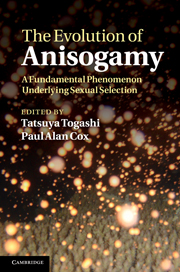Book contents
- Frontmatter
- Contents
- Contributors
- Introduction: The evolutionary mystery of gamete dimorphism
- 1 The origin and maintenance of two sexes (anisogamy), and their gamete sizes by gamete competition
- 2 The evolutionary instability of isogamy
- 3 Contact, not conflict, causes the evolution of anisogamy
- 4 Nucleo-cytoplasmic conflict and the evolution of gamete dimorphism
- 5 Adaptive significance of egg size variation of aquatic organisms in relation to mesoscale features of aquatic environments
- 6 Gamete encounters
- 7 Evolution of anisogamy and related phenomena in marine green algae
- Index
- References
5 - Adaptive significance of egg size variation of aquatic organisms in relation to mesoscale features of aquatic environments
Published online by Cambridge University Press: 19 May 2011
- Frontmatter
- Contents
- Contributors
- Introduction: The evolutionary mystery of gamete dimorphism
- 1 The origin and maintenance of two sexes (anisogamy), and their gamete sizes by gamete competition
- 2 The evolutionary instability of isogamy
- 3 Contact, not conflict, causes the evolution of anisogamy
- 4 Nucleo-cytoplasmic conflict and the evolution of gamete dimorphism
- 5 Adaptive significance of egg size variation of aquatic organisms in relation to mesoscale features of aquatic environments
- 6 Gamete encounters
- 7 Evolution of anisogamy and related phenomena in marine green algae
- Index
- References
Summary
INTRODUCTION
Following evolution of sexual reproduction, which was most likely characterized by the transition from isogamy (equal-sized gametes) to anisogamy (different-sized gametes) and oogamy (large immotile gametes, eggs, and small motile gametes, sperm), a secondary characteristic related to fertilization resulted in the diversification of the life-history traits of organisms (Parker and Tang-Martinez, 2005; Kokko and Jennions, 2008). An understanding of sexual and reproductive characteristics of organisms is an important aspect of the study of life-history evolution. Various questions arise concerning the evolutionary diversification including sex-specific behaviors and morphologies just before and after mating and the fusion of gametes (Andersson, 1994; Danchin et al., 2008).
Size variations – between different gamete types as well as within the same gamete type – evoke questions about the selective pressures on those variations. For example, comparison of + and − type gametes in green algae raises a fundamental question: what selective forces drive gamete size differentiation, and what forces maintain observed size differences between the two types of gametes that unite to create the zygote (Randerson and Hurst, 2001a; 2001b; Togashi et al., 2007; Iyer and Roughgarden, 2008)? One of the most influential explanations for patterns of gamete size distribution comes from game theory, using a model that incorporates the mechanism of disruptive selection (Parker et al., 1972).
- Type
- Chapter
- Information
- The Evolution of AnisogamyA Fundamental Phenomenon Underlying Sexual Selection, pp. 131 - 167Publisher: Cambridge University PressPrint publication year: 2011



